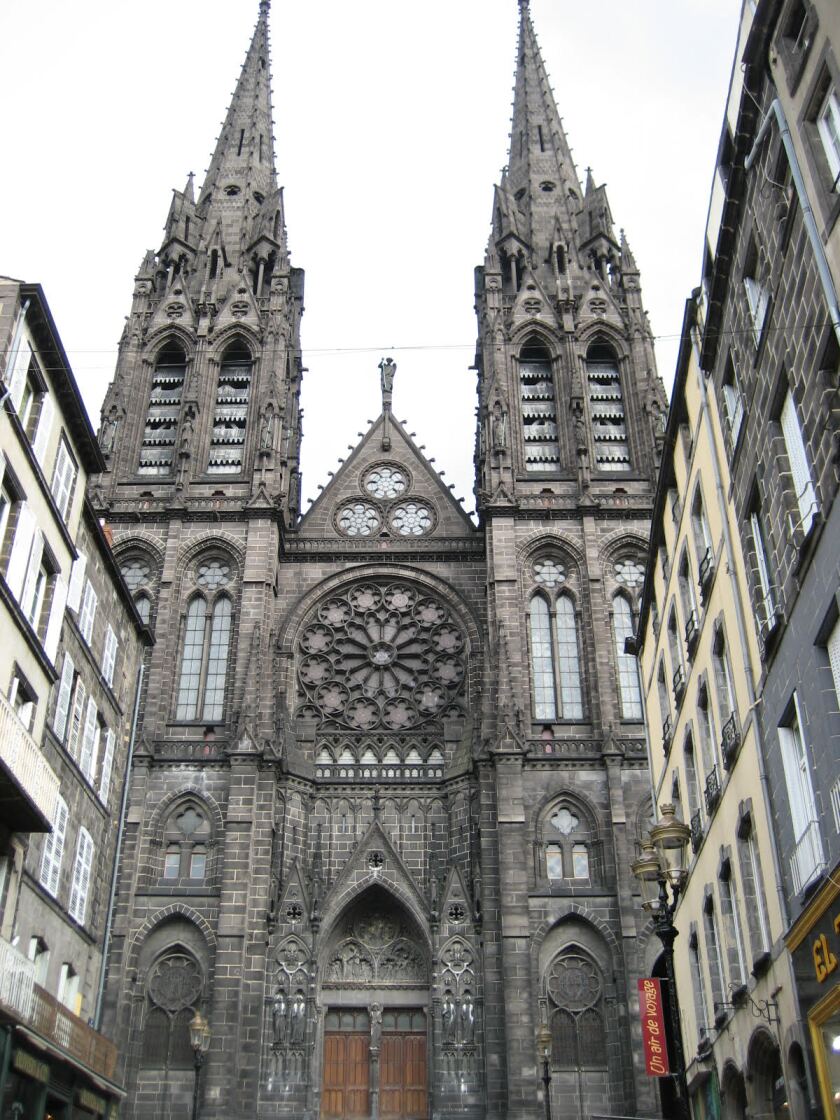Clermont-Ferrand's cathedral keystones have been a mystery for decades—until one undergrad set out to decode their meaning.
Tucked away in the green landscapes of the Auvergne region in France lies the beautiful city of Clermont-Ferrand—and at its center, a big, black Gothic cathedral. Though most of the cathedral’s original furnishings were destroyed during the French Revolution, much of the original architecture remains, including the keystones in its four interior arches. Unlike most cathedrals in the region, Clermont-Ferrand's cathedral keystones have faces on them, pointing to a history that was partially lost during the Revolution. Hoping to uncover the mysteries behind the seven faces, recent graduate Eva Greenwell (French ’24) visited France to research the faces of Clermont-Ferrand and their history.

Researching the Cathedral
Greenwell lived in Clermont-Ferrand until she was a teenager and has many memories of the town. In fall 2023, she took an art history class focusing on Gothic and Romanesque art and found the perfect opportunity to study her hometown through the lens of its art history. Greenwell says, “I did a couple projects for my French classes that related to where I grew up, and it was really meaningful. So, I wanted to work on our cathedral—Cathedral Clermont-Ferrand.” As she researched the cathedral, Greenwell found that its four keystones had unknown faces carved on them. She says, “They didn’t know why these faces were there, and I said, ‘This is an obvious question that I could try to answer with a paper—I'm going to work on this.’”
For months, Greenwell researched the Cathedral, and, using images of four of the keystone’s faces, she created a hypothesis: each face was a different individual in the Tree of Jesse. With this idea in mind—and plenty of Biblical and historical research to back it up—Greenwell used her HUM Grant to go France, hoping to confirm this theory in person.
Visiting the Cathedral
Once she was in France, Greenwell met Evelyn and Henri Hours, a couple that’s part of the Friends of the Cathedral and Sacred Art Association (L’association des Amis de la Cathédrale et de l’Art sacré) and that helps protect and do research on the Cathedral. During the course of her week-long stay, Greenwell and the Hours discussed theories on the keystones, wonders of the Cathedral, and appreciation for the monument. It was through them that Greenwell learned that the keystones didn’t have four faces—they had seven, one on both the east and west side of almost all the stones. She says, “There are seven faces total, but I didn’t know that going into the project—I only had four of them. I get there and they tell me [there are] seven, so I was able to see the four from the west side, but to see the ones from the east, you have to get up in the triforium.”

Typically, the triforium—an interior walkway at the top of the chapel—is closed to the public. But through a series of miraculous events, Greenwell received special permission to not only access the triforium but to take pictures of the three remaining keystone faces. She says, “I was able to get in touch with the right [government official]. I have no idea how—it was literally a miracle.”
With the new faces added to the mix, Greenwell realized her original hypothesis would no longer stand. Back in Utah, she turned to both her knowledge of art history and the help of Associate Professor Elliott Wise (Eucharistic and Liturgical Imagery) to create a new and improved hypothesis—one that includes all seven of the faces of Cathedral Clermont-Ferrand.
Putting a Name to Each Face
Deciphering all of the faces of the Cathedral proved no easy feat and required that Greenwell turn to the monument’s history. She says, “I found documents that talked about the [Cathedral’s] original [saint dedications], and some of them started to line up with the faces that were being presented.” She then pored through documents containing descriptions of the dedicatory saints in texts, the history on the monument’s architects, and even the history of the French monarchy, before forming a new hypothesis. With this research in mind, she now believes the faces are those of the Virgin Mary, St. Anne (Mary’s mother), St. George, St. Bonnet (a local saint), King Philippe III (also known as “The Bold”), Isabelle of Aragon (Philippe’s first wife), and St. John the Baptist.

As Greenwell concludes her project, she looks back at her research with gratitude, as it helped her go outside of her comfort zone to chase something she’s passionate about. This research also helped her provide the town of Clermont-Ferrand with both pictures and extra information on these keystones—ultimately helping future researchers to attempt the same search she now concludes. Greenwell says, “Having put forth this research and gone through this, I feel like now I can have the confidence to know I can do [anything]—no matter what comes in my program next.”
Get started on your HUM Grant today!